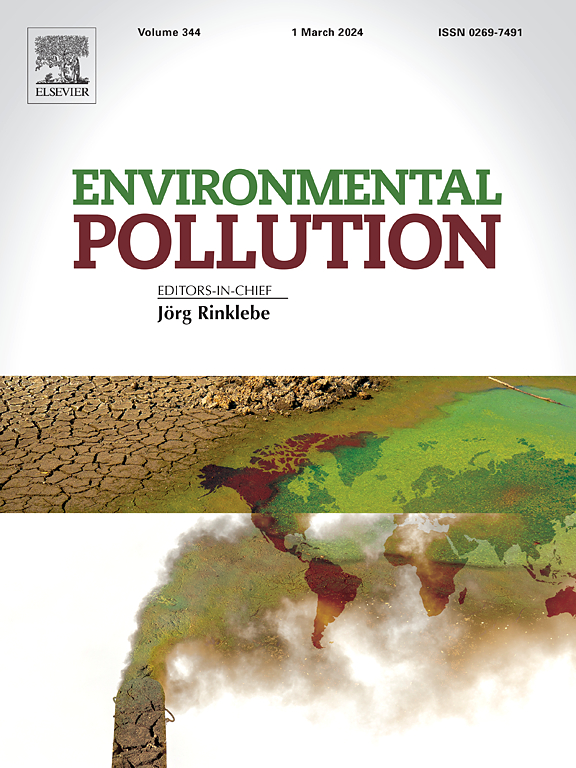纳米二氧化铈(nano - ceo2)对斑马鱼心血管发育的影响及其机制
IF 7.6
2区 环境科学与生态学
Q1 ENVIRONMENTAL SCIENCES
引用次数: 0
摘要
纳米二氧化铈(Nano-CeO2)在农业、工业等领域的广泛应用导致其释放到环境中的量不断增加,成为具有潜在生物危害的污染物。然而,关于二氧化铈对心血管发育影响的研究有限。本研究旨在检测纳米ceo2的心血管毒性,重点研究其对斑马鱼造血功能和心脏发育的影响,并探讨其潜在的分子机制。我们发现,在6 hpf受精后,将斑马鱼胚胎暴露在不同浓度的纳米ceo2中,不会阻碍斑马鱼胚胎在早期的生长发育。然而,RNA-Seq分析表明,斑马鱼的造血系统受到抑制,ecm受体相互作用通路被破坏,相关基因表达明显下调。邻二苯胺染色、中性红染色、苏丹黑染色结果显示,斑马鱼血红蛋白、巨噬细胞、中性粒细胞减少,观察到斑马鱼血管发育不良。同时,纳米ceo2处理斑马鱼幼体心脏中活性氧(ROS)积累,心脏发育相关基因(nppa、hand2、nppb、nkx2.5、myh7)显著下调,gata4上调。整合素激动剂锰离子的加入恢复了ecm受体相互作用通路相关基因的表达,减轻了纳米ceo2引起的心血管异常。此外,长期暴露(受精后120 d)观察到心脏组织病理学的显著变化,表明纳米ceo2暴露影响了斑马鱼心血管系统的发育。综上所述,急性和慢性暴露于纳米ceo2对斑马鱼表现出心血管毒性,影响造血功能和心脏发育,其机制可能与ecm受体相互作用途径有关。本研究为全面了解纳米氧化铈的毒性机制和环境风险提供了有用的信息。本文章由计算机程序翻译,如有差异,请以英文原文为准。


The effect and mechanisms of nano cerium dioxide (Nano-CeO2) on cardiovascular development in zebrafish (Danio rerio)
The widespread application of nano-cerium dioxide (Nano-CeO2) in agriculture, industry, and other fields has led to an increasing amount of it being released into the environment and becoming a pollutant with potential biological hazards. However, studies on the effects of ceria on cardiovascular development were limited. This study aims to detect the cardiovascular toxicity of Nano-CeO2, focusing on its impact on zebrafish hematopoietic function and cardiac development, and to explore its potential molecular mechanisms. We found that exposing zebrafish embryos to different concentrations of Nano-CeO2 after 6 hpf of fertilization does not hinder the growth and development of zebrafish embryos during their early life stages. However, RNA-Seq analysis indicated that the gene expression related to zebrafish hematopoiesis was significantly downregulated, and the ECM-receptor interaction pathway was disrupted.The results of o-dianisidine staining, neutral red staining, and Sudan black staining showed that the hemoglobin, macrophages, and neutrophils of zebrafish were reduced, and the vascular dysplasia of zebrafish was observed. Meanwhile, Reactive oxygen species (ROS) accumulated in the heart of zebrafish larvae treated with Nano-CeO2, and heart development-related genes (nppa, hand2, nppb, nkx2.5, and myh7) were significantly down-regulated, while gata4 was up-regulated. The addition of the integrin agonist manganese ions restored the expression of genes related to ECM-receptor interaction pathways, alleviating cardiovascular abnormalities caused by Nano-CeO2. Besides, significant changes in cardiac histopathology were observed with long-term exposure (120 d post-fertilization), indicating that Nano-CeO2 exposure affected the development of the cardiovascular system in zebrafish. In summary, acute and chronic exposure to Nano-CeO2 exhibits cardiovascular toxicity in zebrafish, affecting hematopoietic function and cardiac development, and the mechanism may be related to the ECM-receptor interaction pathway. This study provides useful information for a comprehensive understanding of the toxicity mechanisms and environmental risks of Nano-CeO2.
求助全文
通过发布文献求助,成功后即可免费获取论文全文。
去求助
来源期刊

Environmental Pollution
环境科学-环境科学
CiteScore
16.00
自引率
6.70%
发文量
2082
审稿时长
2.9 months
期刊介绍:
Environmental Pollution is an international peer-reviewed journal that publishes high-quality research papers and review articles covering all aspects of environmental pollution and its impacts on ecosystems and human health.
Subject areas include, but are not limited to:
• Sources and occurrences of pollutants that are clearly defined and measured in environmental compartments, food and food-related items, and human bodies;
• Interlinks between contaminant exposure and biological, ecological, and human health effects, including those of climate change;
• Contaminants of emerging concerns (including but not limited to antibiotic resistant microorganisms or genes, microplastics/nanoplastics, electronic wastes, light, and noise) and/or their biological, ecological, or human health effects;
• Laboratory and field studies on the remediation/mitigation of environmental pollution via new techniques and with clear links to biological, ecological, or human health effects;
• Modeling of pollution processes, patterns, or trends that is of clear environmental and/or human health interest;
• New techniques that measure and examine environmental occurrences, transport, behavior, and effects of pollutants within the environment or the laboratory, provided that they can be clearly used to address problems within regional or global environmental compartments.
 求助内容:
求助内容: 应助结果提醒方式:
应助结果提醒方式:


